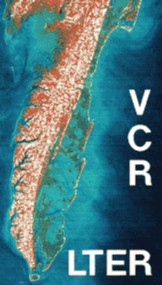
Ecology and Genetics of Rodent Populations on the Southern Delmarva Peninsula
and Virginia Barrier Islands
|

Nancy D. Moncrief, Raymond D. Dueser, C. Randolph Carlson, and John H. Porter
Dept. of Mammals (NDM), Dept. of Fisheries and Wildlife (RDD and CRC), and
Dept. Environmental Sciences (JHP)
Virginia Museum of Natural History (NDM), Utah State University (RDD and
CRC), and University of Virginia (JHP)
|
Abstract
Ecology and Genetics of Rodent Populations on the Southern
Delmarva Peninsula and Virginia Barrier Islands
We are conducting a multidisciplinary study (which simultaneously combines
genetic markers, demographic studies, and topographic surveys) at two island
sites and, for comparative purposes, two sites on the adjacent Delmarva
peninsula. At these four sites we are using capture-recapture techniques
to monitor rodent populations in order to detect differences and similarities
in densities, survival, body mass, reproductive output and dispersal. We
pursue answers to questions such as: Do population of small mammals fluctuate
in abundance on the southern Delmarva Peninsula and adjacent barrier islands?
Are fluctuations in abundance correlated between mainland and island populations?
Can causal factors be determined (or at least some potential causal factors
eliminated) to explain these fluctuations? Are insular populations more
frequently subject to extinction than mainland populations? Do mainland
populations more frequently experience immigration than island populations?
Do the many differences between island and mainland populations that have
been documented by other studies also exist on the Virginia barrier islands?
If not, why not?
To monitor rodent populations at each of the four sites, we are using live
traps (100 per site) permanently positioned at coordinates marked with wooden
stakes at 10 m intervals. Trapping sessions (4 nights) are conducted on
all grids at least once per month May-October. Each time an individual
is captured, its weight and reproductive condition are recorded, along with
the trap location on the grid. On initial capture, the animal is uniquely
marked (using an ear tag), and a small piece of skin (3 mm2 ear clip) is
removed for subsequent genetic analyses.
Grids were established on Myrtle and Ship Shoal islands in October 1995.
In the spring of 1996, trapping grids were established at two mainland
sites: in March at Eastern Shore of Virginia National Wildlife Refuge and
in May at the Shirley Field, near Oyster Virginia.
Results of trapping activities for October 1995 through May 1997 are summarized
in the four tables below. For each site, the total number of individuals
of each species captured during each trapping session is shown. Abbreviations
for scientific names are as follows: Mm = Mus musculus, Mp = Microtus pennsylvanicus,
Op = Oryzomys palustris, Pl = Peromyscus leucopus, Rn = Rattus norvegicus,
Bb = Blarina brevicauda, Sf = Sylvilagus floridanus. Traps were Fitch-type
live traps made with number ten cans, except those marked with an asterisk,
which were Sherman live traps. Two different trapping sessions were conducted
at the mainland sites during each month in July 1996 and August 1996.
Myrtle Island
# trap-
nights month Mm Mp Op
300 Oct 95 42 8 34
300 Mar 96 3 0 0
400 May 96 4 14 0
102 Jun 96 7 24 9
200 Jul 96 1 13 0
400,32* Aug 96 5 23 6
400 Oct 96 6 14 11
400 May 97 4 6 6
Ship Shoal
# trap-
nights month Mp Op
300 Oct 95 18 16
294 Mar 96 10 0
291 May 96 17 1
198 Jun 96 44 1
200 Jul 96 40 2
400,64* Aug 96 43 7
388 Oct 96 27 70
400 May 97 23 12
Eastern Shore of Virginia NWR
# trap-
nights month Mm Mp Op Pl Bb
-- Oct 95
127,60* Mar 96 0 6 0 5 0
400 May 96 0 8 0 0 0
300 Jun 96 0 10 2 0 0
298 Jul 96 0 3 3 2 1
400 Jul 96 0 1 0 1 0
400 Aug 96 0 0 8 1 0
400 Aug 96 2 1 12 0 1
392 Oct 96 6 0 5 5 4
400 May 97 19 23 12 15 0
Shirley Field
# trap-
nights month Mm Mp Sf Cp
-- Oct 95
132 Mar 96 0 1 0 0
300 May 96 0 0 0 0
300 Jun 96 0 6 0 0
299 Jul 96 1 6 0 0
400 Jul 96 0 5 0 0
400 Aug 96 0 2 0 0
400 Aug 96 0 1 0 0
400 Oct 96 0 4 0 1
400 May 97 0 37 1 0
These data are being analyzed and trapping efforts are ongoing. Trapping
sessions are planned for June, July, August, September, and October 1997.
Literature Cited
Return to table of contents.
Submitted by moncrief@amazon.evsc.virginia.edu

